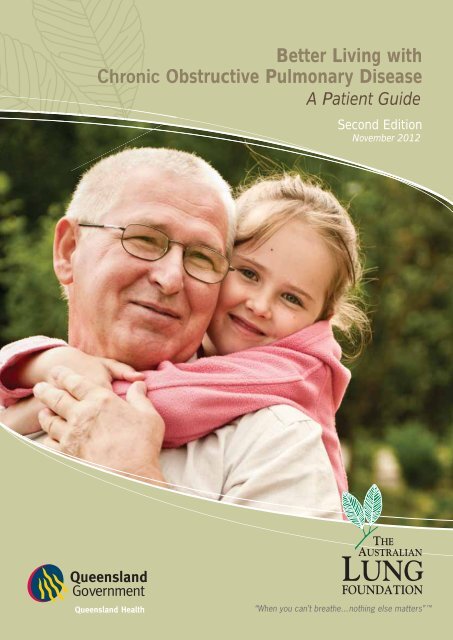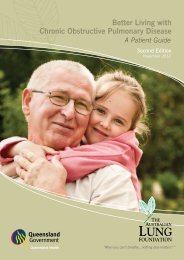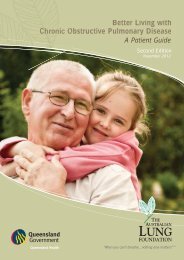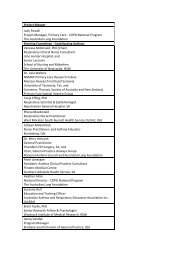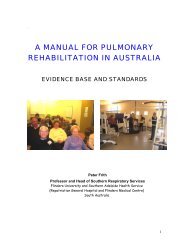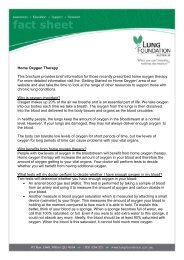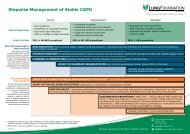Chapter 16: COPD and - Australian Lung Foundation
Chapter 16: COPD and - Australian Lung Foundation
Chapter 16: COPD and - Australian Lung Foundation
Create successful ePaper yourself
Turn your PDF publications into a flip-book with our unique Google optimized e-Paper software.
Better Living with Chronic Obstructive Pulmonary Disease A Patient Guide<br />
Queensl<strong>and</strong> Health<br />
Better Living with<br />
Obstructive Pulmonary Disease<br />
A Patient Guide<br />
Second Edition<br />
November 2012<br />
©The State of Queensl<strong>and</strong> (Queensl<strong>and</strong> Health) <strong>and</strong> The <strong>Australian</strong> <strong>Lung</strong> <strong>Foundation</strong> 2012<br />
a
<strong>Chapter</strong> 5: Your role in managing your chronic obstructive pulmonary disease<br />
Better Living with Chronic Obstructive Pulmonary Disease A Patient Guide<br />
Better Living with Chronic Obstructive Pulmonary Disease A Patient Guide is a joint project of the<br />
Statewide <strong>COPD</strong> Respiratory Network, Clinical Practice Improvement Centre, Queensl<strong>and</strong> Health <strong>and</strong><br />
The <strong>Australian</strong> <strong>Lung</strong> <strong>Foundation</strong>, <strong>COPD</strong> National Program.<br />
This work is copyright <strong>and</strong> copyright ownership is shared between the State of Queensl<strong>and</strong> (Queensl<strong>and</strong> Health)<br />
<strong>and</strong> The <strong>Australian</strong> <strong>Lung</strong> <strong>Foundation</strong> 2012. It may be reproduced in whole or in part for study, education or<br />
clinical purposes subject to the inclusion of an acknowledgement of the source. It may not be reproduced<br />
for commercial use or sale. Reproduction for purposes other than those indicated above requires written<br />
permission from both Queensl<strong>and</strong> Health <strong>and</strong> The <strong>Australian</strong> <strong>Lung</strong> <strong>Foundation</strong>.<br />
© The State of Queensl<strong>and</strong> (Queensl<strong>and</strong> Health) <strong>and</strong> The <strong>Australian</strong> <strong>Lung</strong> <strong>Foundation</strong> 2012.<br />
For further information contact Statewide Respiratory Clinical Network, Patient Safety <strong>and</strong> Quality Improvement<br />
Service, e-mail: PSQ@health.qld.gov.au or phone: (07) 36369505 <strong>and</strong> The <strong>Australian</strong> <strong>Lung</strong> <strong>Foundation</strong>,<br />
e-mail: enquiries@lungfoundation.com.au or phone: 1800 654 301. For permissions beyond the scope of<br />
this licence contact: Intellectual Property Offi cer, Queensl<strong>and</strong> Health, email: ip_offi cer@health.qld.gov.au<br />
or phone (07) 3234 1479.<br />
To order resources or to provide feedback please email: enquiries@lungfoundation.com.au or<br />
phone 1800 654 301.<br />
Queensl<strong>and</strong> Health Statewide Respiratory Clinical Network <strong>and</strong> The <strong>Australian</strong> <strong>Lung</strong> <strong>Foundation</strong>, <strong>COPD</strong><br />
National Program – Better Living with Chronic Obstructive Pulmonary Disease A Patient Guide, 2012.<br />
ISBN 978-0-9872272-0-1
Better Living with Chronic Obstructive Pulmonary Disease A Patient Guide<br />
Chronic obstructive pulmonary<br />
disease <strong>and</strong> swallowing<br />
How are swallowing <strong>and</strong><br />
breathing related?<br />
Swallowing is a highly complex process involving<br />
the coordination of more than 26 muscles <strong>and</strong> six<br />
nerves. For this process to occur smoothly, the body<br />
must also co-ordinate the breathing cycle during the<br />
swallow. Swallowing interrupts breathing. At the<br />
exact moment you swallow, you must momentarily<br />
hold your breath to close the airway. Closing the<br />
airway prevents any food or fl uid from entering the<br />
lungs. The normal swallow–breathing cycle (shown<br />
in steps 1 to 4 in the following diagram) should only<br />
take a few seconds to complete.<br />
chapter<br />
This chapter will help you to underst<strong>and</strong>:<br />
How swallowing <strong>and</strong> breathing are related.<br />
How breathing <strong>and</strong> swallowing are affected by chronic obstructive pulmonary disease (<strong>COPD</strong>).<br />
What the consequences of swallowing problems are.<br />
How you can tell if you are experiencing swallowing problems.<br />
How a speech pathologist can help you with swallowing problems.<br />
What strategies you can use to help manage swallowing problems.<br />
4. Return to<br />
normal<br />
breathing<br />
1. Before the swallow,<br />
breathe in <strong>and</strong> hold breath<br />
2. During the swallow, the<br />
airways remains closed<br />
for about one second<br />
(to prevent food or fl uid<br />
getting into the lungs)<br />
3. After the swallow, breathe out to clear<br />
any remaining food or fl uid from the throat<br />
How are breathing <strong>and</strong> swallowing<br />
affected by <strong>COPD</strong>?<br />
How does <strong>COPD</strong> affect your breathing?<br />
Details of how <strong>COPD</strong> can affect your breathing are<br />
provided in other sections of this Patient Guide (see<br />
chapter 12 ‘Breathlessness, breathing control <strong>and</strong><br />
energy conservation’ on pages 52 to 57). Basically,<br />
<strong>COPD</strong> can cause you to breathe faster, which means<br />
that your breathing muscles can become tired <strong>and</strong><br />
weak. Your coughing refl ex can also become weak.<br />
As breathing <strong>and</strong> swallowing are related, a weak<br />
cough refl ex can cause problems with swallowing.<br />
How does <strong>COPD</strong> affect your swallowing?<br />
Swallowing <strong>and</strong> breathing are related. Many people<br />
with breathing problems also experience diffi culty<br />
co-ordinating breathing <strong>and</strong> swallowing while eating<br />
<strong>and</strong> drinking.<br />
During mealtimes, you may use the swallow–<br />
breathing cycle more than 100 times. People who<br />
have <strong>COPD</strong> often become short of breath during<br />
mealtimes because of the breath-holding that occurs<br />
during the swallowing–breathing cycle. The more<br />
short of breath you become, the more likely you<br />
will fi nd it diffi cult to co-ordinate your breathing<br />
<strong>and</strong> swallowing.<br />
©The State of Queensl<strong>and</strong> (Queensl<strong>and</strong> Health) <strong>and</strong> The <strong>Australian</strong> <strong>Lung</strong> <strong>Foundation</strong> 2012<br />
<strong>16</strong><br />
68
69<br />
Swallowing problems (called dysphagia) can occur<br />
because the need for oxygen will always overrule<br />
the need to protect the lungs from food or fl uids.<br />
What are the consequences<br />
of a swallowing problem?<br />
Swallowing problems <strong>and</strong> aspiration<br />
If breathing timing is even slightly changed during<br />
swallowing, the airway may not be fully closed <strong>and</strong><br />
food or fl uid may be breathed into the lungs. This<br />
is called aspiration <strong>and</strong> may lead to chest infections<br />
or pneumonia.<br />
Normally, when food or fl uid ‘goes down the wrong<br />
way’ (aspirated), you automatically cough up the<br />
food or drink. As people who have <strong>COPD</strong> often have<br />
a weakened cough refl ex, they may not be able to<br />
clear all the food or fl uid out of their breathing tubes<br />
or airways.<br />
Aspiration is a symptom of swallowing problems. The<br />
extent of the swallowing problems can change over<br />
time, <strong>and</strong> may depend on how bad your breathing<br />
problems are at the time (<strong>and</strong> other medical factors).<br />
As many as 20% to 40% of people who have <strong>COPD</strong><br />
experience aspiration (particularly during a fl are up).<br />
<strong>Chapter</strong> <strong>16</strong>: Chronic obstructive pulmonary disease <strong>and</strong> swallowing<br />
Better Living with Chronic Obstructive Pulmonary Disease A Patient Guide<br />
Swallowing problems are often under-diagnosed in<br />
people who have <strong>COPD</strong> because silent aspiration<br />
can be diffi cult to detect.<br />
Swallowing problems <strong>and</strong> nutrition<br />
As you are using more energy to maintain your<br />
breathing during chewing <strong>and</strong> swallowing, eating<br />
<strong>and</strong> drinking can become more tiring. As a result,<br />
you may take longer to complete your meals <strong>and</strong><br />
you may eat <strong>and</strong> drink less. Eating <strong>and</strong> drinking<br />
less could cause you to miss out on important<br />
nutrients <strong>and</strong> lose weight.<br />
How can you tell if you are<br />
experiencing swallowing problems?<br />
Read the following two lists of the common signs of<br />
swallowing problems. Tick the box next to any sign<br />
that you experience when eating <strong>and</strong> drinking:<br />
List 1<br />
❑ Coughing or choking after swallowing<br />
food or drinks.<br />
❑ Increased shortness of breath during meals.<br />
❑ Wet or ‘gurgly’ voice after swallowing.<br />
❑ Feeling like food is getting stuck in the throat.<br />
❑ Diffi culty chewing foods.<br />
❑ Taking longer to start a swallow.<br />
List 2<br />
❑ Food or drink going into your nose.<br />
❑ Food or drink remaining in the mouth<br />
after swallowing.<br />
❑ Refl ux or regurgitation.<br />
❑ Taking much longer to fi nish meals.<br />
❑ Getting more fatigued after eating <strong>and</strong> drinking.<br />
❑ Unexplained weight loss.<br />
❑ Unexplained temperatures or changes in<br />
sputum colour.<br />
If you ticked two to three items (particularly those in<br />
List 1), or are concerned about your swallowing, ask<br />
your GP (or respiratory specialist) to refer you to a<br />
speech pathologist who can assess your swallowing.
Better Living with Chronic Obstructive Pulmonary Disease A Patient Guide<br />
How can speech pathologists help<br />
you with swallowing problems?<br />
Speech pathologists are trained to assess, diagnose<br />
<strong>and</strong> treat swallowing <strong>and</strong> communication problems.<br />
They can:<br />
Assess your current swallowing function <strong>and</strong><br />
determine the cause of your swallowing<br />
problem.<br />
Recommend appropriate foods <strong>and</strong> fl uids, as<br />
well as strategies to improve swallowing safety.<br />
Start you on swallowing therapy, if appropriate.<br />
Identify the need for further investigations.<br />
Liaise with other health care professionals.<br />
If you are experiencing swallowing problems,<br />
a speech pathologist can give you specifi c advice<br />
to help you eat <strong>and</strong> drink safely.<br />
What strategies can you use to help<br />
manage swallowing problems?<br />
Even if you are not experiencing swallowing problems,<br />
you should be aware that there are a number of<br />
strategies that can be used to protect the lungs.<br />
This knowledge could help you if you do encounter<br />
swallowing problems (for example, if you have a<br />
fl are up). These strategies include:<br />
Try not to eat or drink when you are breathless.<br />
Always sit upright in a supported chair when<br />
you are eating <strong>and</strong> drinking.<br />
Eat slowly <strong>and</strong> take small mouthfuls.<br />
Select foods that are soft <strong>and</strong> easy to chew,<br />
or add sauce or gravy to moisten foods.<br />
If worn at home, oxygen prongs should not<br />
be removed during meals.<br />
Have smaller, more frequent meals, <strong>and</strong> take<br />
a break during your meal if you become too<br />
short of breath.<br />
Try to breathe out immediately after you swallow<br />
to help clear any food or fl uid left in your throat.<br />
Alternate between sips of fl uids <strong>and</strong> solids.<br />
Try swallowing twice per mouthful.<br />
Try to minimise talking during mealtimes to<br />
reduce the exertion on your breathing.<br />
Remain upright for 30 minutes after your meal.<br />
If you experience refl ux or heartburn, discuss<br />
anti-refl ux medication with your GP.<br />
Managing swallowing problems due<br />
to dry mouth<br />
People who have <strong>COPD</strong> often experience dry mouth.<br />
Dry mouth can be related to oxygen use (via a mask<br />
or nasal prongs), mouth breathing or medications.<br />
Having a dry mouth is uncomfortable, can increase<br />
the risk of dental problems <strong>and</strong> can cause swallowing<br />
problems. To reduce dry mouth symptoms:<br />
Sip fl uids frequently throughout the day.<br />
Always rinse <strong>and</strong> gargle after taking your<br />
medication or inhalers.<br />
Use artifi cial saliva products (for example,<br />
Biotene ® or Oralube ® ), available at your<br />
local pharmacy, or other oral lubricants<br />
(for example, grape seed oil fl avoured with<br />
peppermint essence).<br />
Suck sugar free lollies or chew gum.<br />
Avoid medicated lozenges or alcohol-based<br />
mouthwashes.<br />
Reduce your intake of caffeine, alcohol <strong>and</strong><br />
spicy foods, <strong>and</strong> avoid smoking.<br />
Regularly brush your teeth <strong>and</strong> gums<br />
(or clean your dentures) to reduce bacteria<br />
build up in your mouth.<br />
Have regular dental check-ups.<br />
Talk to your GP about reviewing the<br />
medications you are taking.<br />
To overcome diffi culties with swallowing<br />
medications, try cutting or crushing your<br />
medications <strong>and</strong> mixing them with yoghurt,<br />
custard or jam before swallowing them.<br />
However, as not all medications can be cut<br />
or crushed, you should always check with<br />
your GP or pharmacist fi rst.<br />
©The State of Queensl<strong>and</strong> (Queensl<strong>and</strong> Health) <strong>and</strong> The <strong>Australian</strong> <strong>Lung</strong> <strong>Foundation</strong> 2012<br />
70


